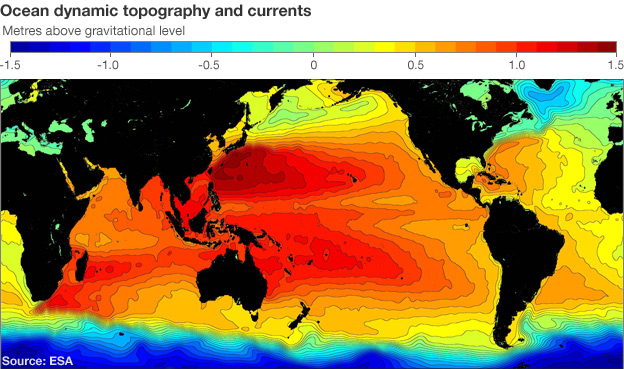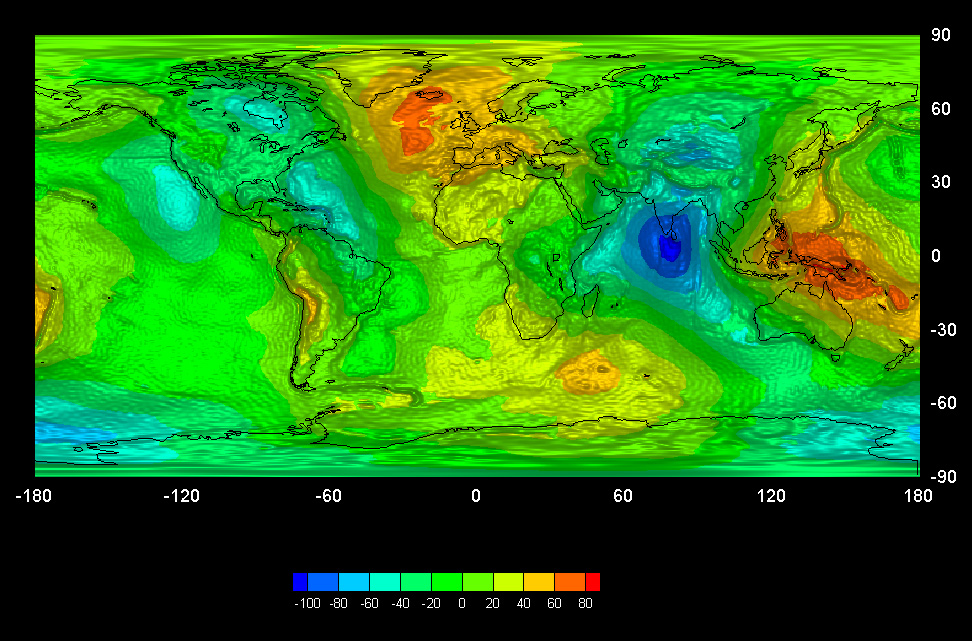Did you ever imagine that you were spinning through space on a giant potato? Need to lose weight? Are you betting on a high number of world records being broken in the 2012 Olympics? Maybe you want to know the best place to build a spaceport or the fastest place to put your supercomputer? There might be some answers in the data from Europe’s GOCE satellite.
Taking a break from working on my content process, (which strangely prevents me from publishing anything at the moment,) I have taken time out and delved into an interesting news report that the Earth looks like a giant potato in space. The image of how gravity looks across the planet is displayed in a video of the rotating globe by Europe’s GOCE satellite. On the image from highest gravity to the lowest the colours are displayed going from yellow, orange, red, turquoise to blue. You can easily see this information would be useful for climate and ocean current studies.
It does show me if I need to lose weight in the UK I could do it simply by moving to somewhere south of India and Sri Lanka. Or maybe climbing the Himalayas is still the best route I haven’t calculated the difference as we speak, so I cannot say. Though, I do remember from recent OU studies that there was a difference of about 0.5% in weight from the poles to the equator.
Immediately, you might wonder why the Earth is so uneven, of course in reality you wouldn’t be able to discern any difference looking at it, this is the gravity field not exactly the shape and the effects are highly exaggerated. However, the differences would be noticeable if you weighed yourself in both the high gravity areas and the lower ones or even measured the sea levels at these points. It doesn’t mean we are riding on a potato through space exactly.
The first thing I compared it with were the plate tectonics and seeing if there was any correlation between that and the differences in
gravity. I would imagine that it the Earth was left alone in the beginning, when it was cooling off it would have been a perfect sphere with gravity equal at every point. Well, introduce the forces of rotation and it would get fatter at the equator and become ellipsoid. However, looking at the gravity across the whole surface of the Earth and you’ll see that things are much more complicated. So there has to be other reasons for all these changes.
Looking at the plate tectonics will show you where mass is moving and where it has built up. It is interesting to think of the massive momentum that is tied up in all that movement and where it was originally created. I would imagine that the bombardment the Earth has had over the billions of years has somehow left its signature in the shape and gravity of the ellipsoid. The core is probably consistent in density, apart from any convection moving the magma around and I wonder if the signature of the moon is left here or was that so long ago the effects have been eroded away.
In any case, other than the shifting of the plates the extra mass in certain areas might be an indicator of meteorite collisions. The Burckle Crater is noticeably close to one of the lowest gravity points possibly where great mass was thrown away from the impact point.
It’s great to consider all the things that could possibly explain the differences in mass around the Earth and I wonder now with the recordings made by GOCE whether enough data might exist for a computer model. The trick would be to identify the external effects and when they might have happened, modelling in zero-g the collision of objects and external gravitational effects. The cracks and shapes of the tectonic plates may well explain also which impacts and forces may have ‘broken’ them in the past.
Another noticeable thing with the Olympics coming up in London next year is that the gravity is so high here, are we to expect less world records? Sounds like this could be a great excuse for anyone to use, “I couldn’t do it because of the high gravity!”. Maybe this is a good case for holding the Olympics in India.
Another great use of this would be looking for places for a spaceport (or elevator), the less gravity would result in less fuel needed, a more economical way to get out there and play, but then again, the same principle might apply for building one on the Himalayan peaks. Either way, it is long overdue and we need to get back out there as quickly as possible.
Also there is the thought that time runs slower the higher the gravitational field, so that would mean a long calculation started at the same time here in the UK and in Sri Lanka would finish at a different times, because the Sri Lankan computer would run faster. Maybe another good reason to put our computational power on the moon.
(I wasted a lot of time after making that statement when I then tried balancing time on a rotating object with different gravities, a circular high gravitational field surrounding a low one spinning on a sphere – picturing a simple Burckle Crater on the Earth. Common sense told me that at some point the time should equalise, balance out somehow, but my maths kept telling me that no synchronisation would ever exist and the one area would run away forward in time??? Where did the time go to? What happens when moving from one time to another? I’ll come back to that one some day, I guess I still haven’t mastered relativity yet???)
Anyway, here’s to riding along this great blue ‘battered and bruised’ Earth, the ride gets more interesting as time goes by! (Or maybe in my case ‘time’ get more interesting the further along the ride I go)


